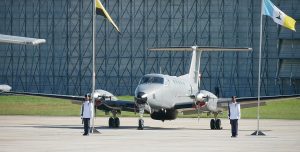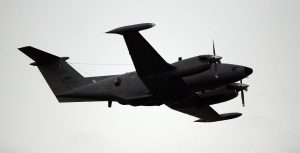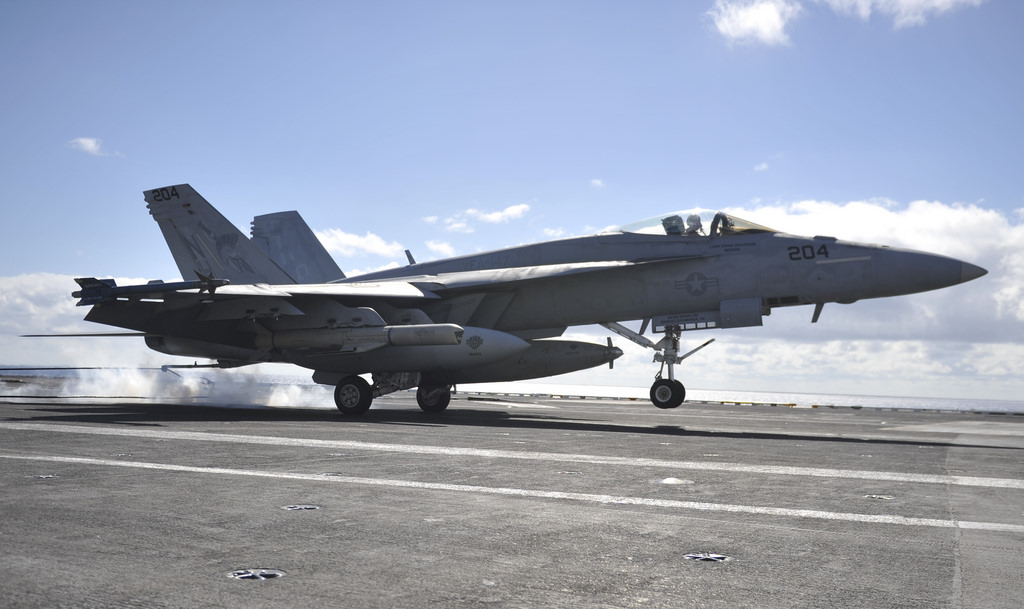
KUALA LUMPUR: A Beechcraft 200T King Air of the 16th Squadron crashed next to the ordnance terminal at the Butterworth airbase at 5.18pm today (Dec. 21), RMAF says in a statement. The aircraft – M41-03 – were carrying 4 crew members when it crashed.
Pilot, Mejar C. Kayamboo was killed while three other crew members were rescued and currently undergoing treatment at several hospitals. The other crew members are identified as co-pilot Kapten Wai Lik, 26, mission system operator Lt Hamdi Ahmad Hanafi and observer Sarjan Mohd Sofi Azizan. Hamdi has been transferred to the Hospital Tentera Tunku Mizan in Kuala Lumpur while Mohd Sofi and Wai Lik are now warded at the Hospital Pulau Pinang.

An investigation board has been set up to determine the cause of the accident. 16th Squadron operates 4 Beechcraft 200T fitted with the Thales Amascos, for maritime surveillance. It is likely that the crew of the ill-fated aircraft was on a training mission. The three remaining aircraft has since been grounded pending investigation into 03 crash.

This was the fifth accident involving RMAF aircraft this year but its the first fatal crash in the last six years, which is the main reason this incident got its own post. Other incidents this year involved two Nuris, an Aermacchi MB339CM and a CN-235.
The last fatal crash involving RMAF was back in 2010 when a PC 7 Mk II crashed at UUM in Sintok, Kedah. The pilot was killed in the crash.
RMAF also operates two Super King Air 350is, on lease from Aerotree Sdn Bhd for liaison and pilot conversion duties. To be updated.
— Malaysian Defence
If you like this post, buy me an espresso. Paypal Payment




rip
Condolence to the family n RIP to the deceased crew member.
RIP…
hopefully next getting better MPA.
Beechcraft b200t are very reliable airplanes. Looks like almost all previous crashes this year is caused by engine issues. Is the budgetary limitations causing shortcuts to the maintenance regime?
With just 3 remaining mpa aircraft in tudm fleet, there is just not enough aircraft to patrol the large eez that Malaysia has. Give priority to something like this, a mpa version of something like the cn-235mpa with winglets of the indonesian navy could be had for like usd30mil each.
what kind of plane still use cable to control the rudder?
Maybe its now definite they will get proper medium MPAs.
Choon,
Many modern aircraft like the B747 and B737 still uses cable to control their flight surfaces. Heck even the modern ‘fly-by-wire’ A320 uses cables to transmit pilot inputs from the rudder pedals to the rudder hydraulic servos. So your point is?
That cable is actually a HF antenna not for rudder control.
Also, prolly we can get a used P-3s and upgrade them to P-3C+. I don’t really like the idea of getting CN-235 (or C-295 for that matter) as MPA especially if they’re built by Indonesia. There’s the SIGINT concern from them
Reply
P-3s are off the table as it will cost more than US$50 million to upgrade them. Lockheed Martin is trying to sell upgraded P-3s for US$80 million per aircraft
undun,
Getting P-3s will be a bad idea as all are over 40 years old. Something newer and with more growth potential is the way to go. For our requirements something the size of a CN-235 or CN-295 will do. There is no SIGINT or any other concerns with buying from Indonesia as such gear is installed by the OEM and the software codes are specific to the end user. What we need are the basics : search radar, FLIR, ESM, the ability to drop rescue gear, etc. In the past some expressed the hope that our future MPA will have torps and ASMs but getting into that game is expensive, not only to buy the stuff but to acquire and maintain the needed skillsets.
……..,
I doubt it. Irrespective of budget cuts aircraft still undergo regular routine checks at squadron level after ‘x’ hours flown and depot level maintenance at AIROD. The first to go when belts are tightened are flying hours. It is telling that the accident happened when the aircraft was in its final approach : probably either human error or a technical issue.
Condolence to their family. And RIP to deceased crew.
” The first to go when belts are tightened are flying hours.”
How did you know and what would be second or third to go?
Would it be the frequency of firing live ordnance, number and coverage of alert aircraft, number of flying status pilots and crew?
Reply
I am not sure about what will be Azlan answer but yes the reducing flight hours will be the first thing they do. During the 1998 economic crisis reduction of flight hours was among the cost cutting measures. When they reduced the flight hours everything else you mentioned will also be affected but those things are usually kept as rahsia. Its the same for support reduction in flight hours will prolong the service intervals though things which are governed by other things like expiration dates will need to be replaced.lq
There is no need to get a CN series air craft to replace the crashed one. We can get another brand new Beechcraft but just make sure its the latest varient with the ER or extended range provided. That should be enough. Better still equipp all existing Beechcrafts with Ir N sensing gear for night ops n better still if can also equip with SIGINT electronics too. But just equip with a maritime radar would be good enough. Perhaps instead of new purchase, convert one of the two transports with a Radar n COSCO system. That would be the cheapest alternative.
RIP Mejar C. Kayamboo . Condolences to his family.
Hope the rest of the crew recover n return to active duty.
The Beechcraft does have radar and FLIR. What it does not have is room for any more equipment and equipment operators, and it is cramped and uncomfortable for long flights as crew are not even able to stand up straight
Lee – ” We can get another brand new Beechcraft but just make sure its the latest varient with the ER”
No. The issue with the Beechcraft its size, not its sensors which in the form of AMASCOS is pretty decent.
Lee – ”or extended range provided.”
With drop tanks [since replaced by wing tip fuel tanks], the Beechcraft has decent endurance [more than 10 hours, depending on several factors] but is too small and weight is a major issue.
If you looked into the interior of a Beechcraft you would realise why it’s not suitable for our operational requirements. With something the size of a CN-235 or a CN-295 there is ample internal space for whatever we want to place on it and even space for extra crew members. A major advantage of going with CNs is that we already have a simulator for it and a trained pool of crews and support personnel already in place. Whether the RMN prefers CN-235s or CN-295 remains to be seen.
AM – ”How did you know and what would be second or third to go?
Would it be the frequency of firing live ordnance, number and coverage of alert aircraft, number of flying status pilots and crew?”
As Marhalim also pointed out, the first to go will always be hours; makes sense as flying hours are not cheap and the more a plane flies the more checks and maintenance is needed. This was the case in 1997 when operational and training sorties were severely cut. QRAs are not affected but exercises always are; as to be expected.
Routine preventive maintenance at squadron level after ‘x’ hours of flying still goes on but depot level maintenance can be dragged – same goes with the RMN when ships scheduled for overhauls are sometimes delayed due to budgetary or operational issues.
As it stands, there has long been a requirement for MPAs but no cash has been allocated. With only 3 Beechcrafts left, meeting operational requirements no doubt will be an issue but at least we still have the C-130MPAs [which are still used for patrolling despite their main sensor being the Mk1 eyeball] and the MMEA’s Bombardiers. RAAF P-3s still make regular deployments from Butterworth over our waters but of course these are under the operational control of HQIADS.
On another matter, from time to time people make disparaging
remarks like ”hangar queens” and so on but this is totally false. One of the problems we initially faced with the Hawks was a higher than normal utilisation rate [an RMAF Chief went public with this in 1995] and a problem with the Fulcrums is that we flew them with more regularity than the OEM recommended based on Soviet/Russian practice and the TBO/MTBF of the RD-33s. Even in times when the economy is slow, the MKMs and Hornets are still flying daily; as anyone who lives in Penang and near Gong Kedak will attest to.
I was told the RSAF Fokker 50 MPA has a typical mission time of six hours. Even so, they carry two mission crews of three men each.
The Fokker 50s originally carried search radar in the belly or nothing special at all (just like the Skyvans they replaced).
Later came wingtip and tail missile warning receivers when they deployed on the anti piracy mission. Probably (but not sure) at the same time, EO ball under the nose and two Harpoons on the waist. There is no ASW capability.
The trouble with “Soviet/Russian practice” is you will be hard pressed to meet Western flying hours standards and pilot:aircraft ratios.
If you ask me about the features of the aircraft, i think it should be purchased to serve under the police air wing. This goes to the Fennec too.They doesn’t have the militarized look at all. But still, its all about the functions right.
I was shocked to watch it on TV as you know what I did.For 20 years, this type of planes flew with no problem. The mishap photo showed the plane was near the airbase fence meaning the brake of the plane failed.
It could not stop and stopped at the edge of the base. The maintenance of the plane played a major factor.My condolences to the family of the late pilot Mejar C. Kayamboo, 45 on his birthday remembered as his death anniversary.
Reply
The fencing is not the end of the runway but the extra one they have for the ordnance terminal. If you check out Google map you can see it yourself
AM – ”There is no ASW capability.”
The RTN has a few P-3s with also no ASW capability. Having an MPA with a ASW capability is great but it comes with a price. Like EW and other stuff; getting into the airborne ASW game and maintaining the needed skill sets is resource intensive and expensive. A MPA configured for ASW should not only have MAD but also sufficient internal space to carry a decent number of sonobuoys [which the Wildcat doesn’t despite it being considered by us for ASW].
AM – ”The trouble with “Soviet/Russian practice” is you will be hard pressed to meet Western flying hours standards and pilot:aircraft ratios.”
True but for the Soviets; I guess their answer would be is that they didn’t have to ”meet Western flying hours standards and pilot:aircraft ratios.” For a start they were under no illusions that fighters would last more than a few sorties before being destroyed; same with MBTs.
Another problem is that Soviet industry was incapable of churning out engines which lasted as long as Western equivalents. Or maybe they felt there was no need to given the short expected life span of a fighter, had the Cold War turned hot. Lets see what happens with the PAK-FA, as to whether its engines and other components will have longer TBOs and MTBFs.
Ahmad Zaki – ”The maintenance of the plane played a major factor.”
We’ll have to wait and see what the results of the inquiry are. My guess is that it was either human error or a technical glitch.